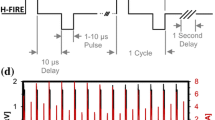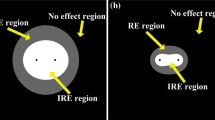Abstract
We introduce and characterize the use of MRI for studying nonthermal irreversible electroporation (NTIRE) in a vegetative tissue model. NTIRE is a new minimally invasive surgical technique for tissue ablation in which microsecond, high electric-field pulses form nanoscale defects in the cell membrane that lead to cell death. Clinical NTIRE sequences were applied to a potato tuber tissue model. The potato is used for NTIRE studies because cell damage is readily visible with optical means through a natural oxidation process of released intracellular enzymes (polyphenol oxidase) and the formation of brown-black melanins. MRI sequences of the treated area were taken at various times before and after NTIRE and compared with photographic images. A comparison was made between T1W, T2W, FLAIR and STIR MRIs of NTIRE and photographic images. Some MRI sequences show changes in areas treated by irreversible electroporation. T1W and FLAIR produce brighter images of the treated areas. In contrast, the signal was lost from the treated area when a suppression technique, STIR, was used. There was similarity between optical photographic images of the treated tissue and MRIs of the same areas. This is the first study to characterize MRI of NTIRE in vegetative tissue. We find that NTIRE produces changes in vegetative tissue that can be imaged by certain MRI sequences. This could make MRI an effective tool to study the fundamentals of NTIRE in nonanimal tissue.






Similar content being viewed by others
References
Davalos RV, Rubinsky B (2008) Temperature considerations during irreversible electroporation. Int J Heat Mass Transf 51:5617–5622
Davalos RV, Mir IL, Rubinsky B (2005) Tissue ablation with irreversible electroporation. Ann Biomed Eng 33:223–231
Edd JF, Horowitz L, Davalos RV, Mir LM, Rubinsky B (2006) In vivo results of a new focal tissue ablation technique: irreversible electroporation. IEEE Trans Biomed Eng 53:1409–1415
Gilbert JC, Onik GM, Haddick W, Rubinsky B (1984) The use of ultrasonic imaging for monitoring cryosurgery. In: Proceedings of the 6th annual conference, IEEE engineering in medicine and biology, pp 107–112
Ivorra I, Mir LM, Rubinsky B (2009) Electric field redistribution due to conductivity changes during tissue electroporation: experiments with a simple vegetal model. In: World congress 2009 on medical physics and biomedical engineering, 7–12 Sept 2009, Munich, Germany, IFMBE proceedings, vol 25, pp 59–62
Lee RC, Kolodney MS (1987) Electrical injury mechanisms: electrical breakdown of cell membranes. Plast Reconstr Surg 80:672–679
Lee RC, Gaylor DC, Bhatt D, Israel DA (1988) Role of cell membrane rupture in the pathogenesis of electrical trauma. J Surg Res 44:709–719
Lee EW, Loh CT, Kee ST (2007) Imaging guided percutaneous irreversible electroporation: ultrasound and immunohistological correlation. Technol Cancer Res Treat 6:287–294
Makover RU, Schwimmer S (1954) Inhibition of enzymic color formation in potato by ATP. Biochim Biophys Acta 14:156–157
Neumann E, Schaefer-Ridder M, Wang Y, Hofschneider PH (1982) Gene transfer into mouse lyoma cells by electroporation in high electric fields. EMBO J 1:841–845
Onik G, Mikus P, Rubinsky B (2007) Irreversible electroporation: implications for prostate ablation. Technol Cancer Res Treat 6:295–300
Rubinsky B (ed) (2010) Irreversible electroporation. Series in Biomedical Engineering XIV. Springer, New York
Rubinsky B, Onik G, Mikus P (2007) Irreversible electroporation: a new ablation modality—clinical implications. Technol Cancer Res Treat 6:37–48
Russell WMS, Burch RL (1959) The principles of humane experimental technique. Methuen, London
Weaver JC (2000) Electroporation of cells and tissues. IEEE Trans Plasma Sci 28:24–33
Acknowledgements
This study was supported by a gift from the Adelson Family Foundation. We are grateful to the Medical Imaging Department, Makassed Hospital, Jerusalem, for making this study possible.
Author information
Authors and Affiliations
Corresponding author
Rights and permissions
About this article
Cite this article
Hjouj, M., Rubinsky, B. Magnetic Resonance Imaging Characteristics of Nonthermal Irreversible Electroporation in Vegetable Tissue. J Membrane Biol 236, 137–146 (2010). https://doi.org/10.1007/s00232-010-9281-2
Received:
Accepted:
Published:
Issue Date:
DOI: https://doi.org/10.1007/s00232-010-9281-2




